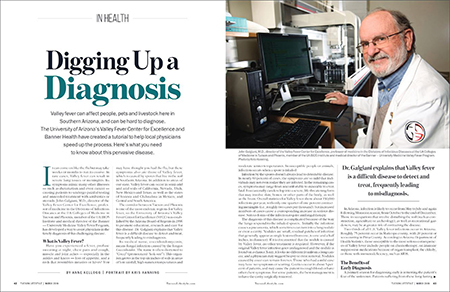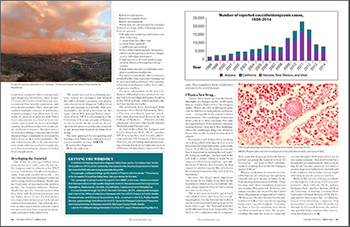 Valley fever affects people, pets and livestock in Southern Arizona and beyond, notes Tucson Lifestyle
Valley fever affects people, pets and livestock in Southern Arizona and beyond, notes Tucson Lifestyle  in an “In Health” feature, published in the magazine’s March 2019 issue. But the primarily respiratory disease caused by fungal spores found in arid soils of the Southwest can be hard to diagnose.
in an “In Health” feature, published in the magazine’s March 2019 issue. But the primarily respiratory disease caused by fungal spores found in arid soils of the Southwest can be hard to diagnose.
Most human cases are found along the Interstate 10 corridor between Tucson and Phoenix and in the San Joaquin and Imperial Valley in Central California, one of the world's most productive agricultural regions.
Magazines
When inhaled, the spores of Coccidioides, a fungus endemic to the Southwest, can create an infection, coccidioidomycosis or cocci, that exhibits many of the  symptoms of flu or pneumonia. And, as a result, many cases are initially treated with antibiotics instead of antifungals. In some people, reactions may be negligible and recovery quick, but in other more vulnerable populations¹ it can spread beyond the lungs and kill. That’s why a quick and correct diagnosis is so important.
symptoms of flu or pneumonia. And, as a result, many cases are initially treated with antibiotics instead of antifungals. In some people, reactions may be negligible and recovery quick, but in other more vulnerable populations¹ it can spread beyond the lungs and kill. That’s why a quick and correct diagnosis is so important.
¹ Rates of Valley fever are typically highest among people age 60 and older. [Source: CDC]
 Image at right is of accompanying ad in Tucson Lifestyle of Banner – University Medical Center Tucson new nine-story hospital tower set for grand opening in mid-April. The Cyclovia Tucson/Living Streets Alliance will host the site as part of its April 7 community walk/bike/dance festivities. Click the images above and at right to enlarge!
Image at right is of accompanying ad in Tucson Lifestyle of Banner – University Medical Center Tucson new nine-story hospital tower set for grand opening in mid-April. The Cyclovia Tucson/Living Streets Alliance will host the site as part of its April 7 community walk/bike/dance festivities. Click the images above and at right to enlarge!
The University of Arizona Valley Fever Center for Excellence and Banner Health have created a new clinical practice protocol that they’ve made publicly available and are engaged in community physician training across the Banner system to speed that process up.
The Tucson Lifestyle article, “Digging Up A Diagnosis,” (click left to view) by executive editor Anne Kellogg offers a tutorial on “what you need to know about this pervasive disease.” In it, John N. Galgiani, MD, UA Infectious Diseases professor, Valley fever center founding director, and medical director of the Banner – University Medicine Valley Fever Program, refers to the protocol as “one of the most positive things to come out of the merger between Banner Health and the UA faculty medical group.”
Billboards
 A sidebar to the article also refers to a Valley fever awareness billboard campaign in Phoenix this month in partnership with the center, Arizona Department of Health Services (ADHS) and Maricopa County Department of Public Health, and funded by a UA Foundation grant from a diagnostic test company, IMMY, from Norman, Okla.
A sidebar to the article also refers to a Valley fever awareness billboard campaign in Phoenix this month in partnership with the center, Arizona Department of Health Services (ADHS) and Maricopa County Department of Public Health, and funded by a UA Foundation grant from a diagnostic test company, IMMY, from Norman, Okla.
Dr. Galgiani got a chance to see the billboards last week, while he was in Sun City, Ariz., a suburb northwest of Phoenix, last week to train physicians on the protocols at Banner Del E. Webb Medical Center.
 In Person
In Person
Earlier this week, he was in Rockville, Md., for a two-day conference, “Vaccine Strategies for Endemic Fungal Pathogens,” hosted by the National Institute of Allergy and Infectious Diseases, a unit of the National Institutes of Health. He and Lisa Shubitz, DVM, a Valley fever center associate research professor whose focus is development of a vaccine for dogs, presented on “Vaccines to Prevent Coccidioidomycosis: 60 Years and Counting.” Another UA presenter Neil Ampel, MD, a professor emeritus who worked with the UA Division of Infectious Diseases and Southern Arizona VA Health Care System, spoke on, “Markers of Protective Immunity in Human Coccidioidomycosis.”
Afterward, Dr. Galgiani attended a Valley Fever Roundtable hosted by U.S. Reps. Kevin McCarthy (R.-Bakersfield, Calif.) and David Schweikert (R.-Phoenix), co-chairs of the Congressional Valley Fever Task Force, in Washington, D.C. The event offered an opportunity for leading researchers, patient advocates, doctors, and scientists to update members of Congress on work to improve diagnosis and treatment as well as to develop a vaccine for Valley fever.
“The one for humans is the one for dogs after we prove it successful in dogs,” Dr. Galgiani said. “The idea is we’re doing dogs first as proof of concept that it will work. It shows that it’s effective for a different species other than mice. And when that works, we’ll ask why not use it for humans.”
In the meantime, the Valley fever center has been involved in testing of various detection and treatment options for Valley fever in humans and animals, including use of fluconazole to manage symptoms.
A separate study looking for biomarkers to indicate people susceptible to the more severe form of Valley fever, disseminated cocci—when infection spreads past the lungs to blood and bones, is now actively recruiting patient volunteers at Banner – University Medical Center Tucson and Banner – UMC Phoenix.
“We set it up specifically for people to be recruited who report to the ERs at these hospitals with symptoms for the disease,” Dr. Galgiani said.
By the Numbers
One thing the Tucson Lifestyle article may be obsolete on is where the most number of Valley fever cases occur. Typically, the Tucson-Phoenix corridor is credited with two-thirds of such cases. Recent reports of the ADHS, California Department of Public Health and U.S. Centers for Disease Control and Prevention (CDC), though, reveal a repeat of what was thought to be a fluke last year of more reported cases in the Golden State may have staying power, however inglorious the honor.
State-Reported Data
- Arizona: 2018 – 7,636² | 2017 – 6,885 | 2016 – 6,101 | 2015 – 7,622 | 2014 – 5,624
- California: 2018 – 8,187² | 2017 – 7,534² | 2016 – 5,706² | 2015 – 3,140² | 2014 – 2,306²
The above numbers from the states differ from the final CDC annual report, which reviews reported numbers for duplication, etc., thus reducing final figures. Those numbers are listed below:
Final Federal Data
- Arizona: 2018 – 7,636² | 2017 – 6,885 | 2016 – 6,101 | 2015 – 7,622 | 2014 – 5,624
- California: 2018 – 8,187² | 2017 – 6,925 | 2016 – 5,358 | 2015 – 3,053 | 2014 – 2,243
² Provisional numbers that have to be checked for duplicate reports, etc., before finalized for report by the National Notifiable Diseases Surveillance System (NNDSS).
Ken Komatzu, MPH, the Arizona state epidemiologist, noted he already lowered the provisional cases of Valley fever in Arizona to 7,555 and final numbers for 2018 from the CDC won’t be out until May. Still, overall final numbers nationwide were up from 8,232 reported cases in 2014 to 14,364 last year. That figure is down from a 2009-12 spike peaking in 2011 with 22,641 Valley fever reported cases that year.
“The state numbers were news because it was the first year that California was ahead of Arizona,” Dr. Galgiani said. “It was an anomaly. Maybe it will keep going... because they’re getting better at reporting. So are we.”
EXTRA INFO: Valley Fever in the News
“Congressman McCarthy Leads Valley Fever Roundtable at U.S. Capitol” | (Mojave Desert News) Posted March 7, 2019
WASHINGTON, D.C. – Today, Congressman Kevin McCarthy, Co-Chair of the Congressional Valley Fever Task Force, held a Valley Fever roundtable with Members of Congress, leading researchers, patient advocates, doctors, and scientists from the CDC and National Institutes of Health…
“Assemblymember Salas Advances Valley Fever Bill to Improve Worker Safety” | (The Hanford Sentinel) Posted March 7, 2019
HANFORD, Calif. – The Assembly Committee on Labor unanimously approved Assembly Bill (AB) 203, authored by Assemblymember Rudy Salas (D-Bakersfield), which would strengthen and improve education and protections for workers from valley fever by requiring construction employers in endemic counties to provide effective awareness and prevention training to employees…
“Valley Fever Awareness Poster Winners Announced by ADHS, VFCE” | (DOM News) Posted Feb. 27, 2019
TUCSON, Ariz. – With a series of Facebook posts over the two weeks, the UA Valley Fever Center for Excellence has helped promote the Arizona Department of Health Services announcement of winners in last fall’s Valley Fever Awareness Poster Contest. In all 12 children were recognized, ranging in age from 5 to 17. A 9-year-old from Phoenix and 17-year-old from Tucson won the grand prizes…
“MedWatch Today: Near Death Experience with Valley Fever” | (KSEE24/YourCentralValley.com) Posted Feb. 15, 2019
FRESNO, Calif. – Hear the wild story about one man's journey with Valley Fever. Doctors say he was on the verge of death but Community Medical Centers helped to save his life…
“Billboards, Magazine Article Raise Profile for Valley Fever Awareness in March” | (DOM News) February 8, 2019
TUCSON, Ariz. – Public awareness of respiratory risks for Valley fever infection gets a boost this spring with a billboard campaign in Phoenix and a Tucson Lifestyle article. Look for the billboards after March 4 on I-10 between Elliot and Guadalupe Roads and the AZ-101/AZ-202 Loop interchange. The article serves as the March “In Health” feature and puts the spotlight on Drs. John Galgiani and Fariba Donovan's efforts to train physicians on new clinical guidance protocols…
“Rise in potentially deadly Valley Fever documented in San Luis Obispo County” | (KSBY-6 News) Posted Feb. 8, 2019
SAN LUIS OBISPO, Calif. – It can last for years after diagnosed. Valley fever, a fungus found in the soil, is contracted by breathing in spores kicked up into the air. Documented cases across the Golden State rose 11 percent in 2018 with nearly 8,200 cases, according to a report released by CDPH last week. In San Luis Obispo County, 2018 saw 460 cases diagnosed, a 450 percent increase from the 102 cases in 2010. Meanwhile, Kern County has the highest number of diagnosed in the state with more than 3,000 cases…
“Among the hidden victims of valley fever: domesticated dogs” | (Bakersfield.com/The Bakersfield Californian) Posted Feb. 2, 2019
BAKERSFIELD, Calif. – Valley fever infects thousands of people in Kern County each year, but thousands of other cases could be flying under the radar. Animals, too, can contract the respiratory disease, but the problem remains largely unstudied in Bakersfield, despite the region's status as one of the hottest Valley fever regions in the country. “There is no good information about how many animals get valley fever,” said veterinarian Lisa Shubitz, a research scientist at the University of Arizona Valley Fever Center for Excellence. “It’s not reported…”
ALSO SEE:
“New UA/Banner Health Valley Fever Clinical Guidance Designed to Avert Diagnoses Delays” | Posted Oct. 8, 2018
“Patient-Ordered Tests Indicate Valley Fever Uptick in State, UA Infectious Diseases Specialist Says” | Posted June 12, 2018
“National Institutes of Health Awards $4.8 Million to UA Valley Fever Center for Excellence to Develop Vaccine” | Posted Aug. 24, 2017
“UA Researchers Land $2.27M Grant to Study Genetic Basis for Why Some Don’t Get Valley Fever, Some Die of It” | Posted April 8, 2017

